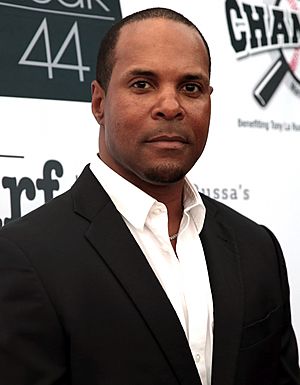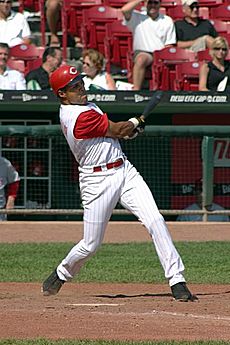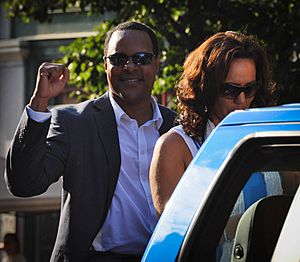Barry Larkin facts for kids
Quick facts for kids Barry Larkin |
|||
|---|---|---|---|

Larkin in 2017
|
|||
| Shortstop | |||
| Born: April 28, 1964 Cincinnati, Ohio, U.S. |
|||
|
|||
| debut | |||
| August 13, 1986, for the Cincinnati Reds | |||
| Last appearance | |||
| October 3, 2004, for the Cincinnati Reds | |||
| MLB statistics | |||
| Batting average | .295 | ||
| Hits | 2,340 | ||
| Home runs | 198 | ||
| Runs batted in | 960 | ||
| Stolen bases | 379 | ||
| Teams | |||
|
|||
| Career highlights and awards | |||
|
|||
| Induction | 2012 | ||
| Vote | 86.4% (third ballot) | ||
Barry Louis Larkin, born on April 28, 1964, is a famous American former professional baseball player. He played as a shortstop for his entire 19-year career in Major League Baseball (MLB). He was always with the Cincinnati Reds from 1986 to 2004.
Before joining the MLB, he played briefly in the minor leagues. He quickly became the starting shortstop for the Reds. Barry Larkin had many great seasons with the team. From 1997 to 2003, he faced several injuries. These injuries limited how much he could play in some seasons.
After retiring in 2004, Larkin worked for the Washington Nationals in their front office. Later, he joined ESPN as a baseball expert. He also coached for the American team in the 2009 World Baseball Classic. In 2013, he managed the Brazilian national team for the same event.
Barry Larkin is known as one of the best players of his time. He won nine Silver Slugger awards and three Gold Glove awards. In 1995, he won the National League Most Valuable Player Award. He was chosen for the Major League All-Star Game twelve times. He was also a key player when the Reds won the World Series in 1990. In 2012, Larkin was voted into the National Baseball Hall of Fame.
Contents
Growing Up and School
Barry Larkin was born and grew up in Silverton, Ohio, a suburb of Cincinnati. He was raised Catholic and went to Archbishop Moeller High School. He first got a football scholarship to the University of Michigan to play for coach Bo Schembechler.
However, in his first year, he decided to focus only on baseball. He was named an All-American twice. He helped the Wolverines reach the College World Series in 1983 and 1984. Larkin was also named Big Ten Player of the Year in 1984 and 1985. His jersey number 16 was retired by the school on May 1, 2010. Larkin also played for the United States team in Baseball at the 1984 Summer Olympics.
Starting His Professional Journey
Minor League Baseball
Barry Larkin played for the Vermont Reds in 1985. His team won the Eastern League Championship that year. In 1986, he was named Rookie of the Year and AAA Player of the Year with the Denver Zephyrs. Overall, he played only 177 minor league games before moving to the major leagues.
Playing in the Major Leagues
Early Career Highlights
When Larkin joined the major leagues, he competed with another player, Kurt Stillwell, for the starting shortstop position. By 1987, Larkin had become the main starter. In 1988, he struck out only 24 times in 588 turns at bat, which was the fewest among all major league players.
In the 1990 World Series, Larkin batted .353. This helped the Reds win against the Oakland Athletics in a four-game sweep. On June 27–28, 1991, Larkin made history. He became the first shortstop to hit five home runs in two games in a row. That season, he was chosen for his fourth straight All-Star Game.
After the 1991 season, Larkin wondered if the Reds were serious about winning. He thought he might leave the team when his contract ended. But he felt better when the Reds got new pitchers, Tim Belcher and Greg Swindell. In January 1992, the Reds signed him to a five-year contract worth $25.6 million. At that time, only four other players had bigger contracts. Larkin was the highest-paid shortstop.
He was not an All-Star in 1992, but he won his fifth Silver Slugger Award in a row. In 1993, he received the Roberto Clemente Award. This award honors players for their sportsmanship, community work, and skill on the field. In 1995, Larkin had a .319 batting average and was second in stolen bases with 51. He won the National League's MVP award. He was the first shortstop to win it since Maury Wills in 1962. He led the Reds to win the National League Central division title. They also reached the 1995 National League Championship Series. There, he batted .389, but the Reds lost to the Atlanta Braves.
In 1996, Larkin hit a career-high 33 home runs and stole 36 bases. He became the first shortstop in Major League history to join the 30–30 club. This means he had at least 30 home runs and 30 stolen bases in one season. Many people thought his 1996 season was even better than his MVP year in 1995.
Mid-Career Challenges
Larkin was named the Reds' captain before the 1997 season. He was the first player to have this honor since Dave Concepción retired. From 1997 onwards, Larkin faced many injuries. He missed 55 games that year because of problems with his calf and Achilles tendon.
In 1998, about three weeks before the season started, Larkin had neck surgery. He was not in severe pain, but he could not lift his arm enough to play defense. On September 27, 1998, Barry, his brother Stephen Larkin, and two other brothers, Bret Boone and Aaron Boone, all played in the infield together. This was the first time in MLB history that an entire infield was made up of two pairs of brothers.
In 1999, Larkin was almost traded to the Los Angeles Dodgers. He later said that someone from the Dodgers gave him a jersey with his name on it. This jersey was ready in case the trade happened. Also in 1999, Larkin worked as an analyst for NBC's coverage of the World Series.
In July 2000, Larkin stopped a trade to the New York Mets so he could stay with the Reds. The Mets would have sent three players to the Reds for Larkin. Larkin said he would have gone to New York, but the Mets did not want to sign him to a long-term contract. The Reds then signed him to a three-year contract extension worth $27 million. In 2000, Larkin missed 59 games because he injured his finger twice and sprained his knee. He had finger surgery in April and knee surgery in September.
Later Career and Retirement
In 2001, Larkin struggled with a groin injury. This led to some people criticizing his play. By August, the injury had limited him to only 45 games. He had surgery for a hernia, which ended his season. In 2002, Larkin played in 145 games. However, he had his lowest batting average (.245) since his first full year in the major leagues. He also dealt with injuries to his rib cage, hamstring, shoulder, neck, and toe.
In 2003, Larkin was on the disabled list twice by late May due to calf injuries. He almost left the team during difficult contract talks with Reds COO John Allen. But Larkin and the Reds agreed to a one-year contract for 2004. Larkin called off a planned retirement ceremony for October 2, 2004, because he was not sure if he would retire. That season, Larkin had a .289 batting average. He officially announced his retirement in February 2005.
After such a strong final season, sports writer Terence Moore compared Larkin's retirement to that of baseball legend Ted Williams. He said Larkin showed what a healthy player could still do. In his 19 years with Cincinnati, Larkin had a .295 batting average. He also had 2,340 hits, 198 home runs, 960 RBI, 1,329 runs scored, and 379 stolen bases. Baseball expert Bill James called Larkin one of the greatest shortstops ever, ranking him #6 all time.
Even though he missed many games in six seasons, Larkin won the Gold Glove Award three times (1994–1996). He was also a 12-time All-Star (1988–1991, 1993–1997, 1999, 2000, and 2004). In 1996, he became the first major league shortstop to join the 30–30 club with 33 home runs and 36 stolen bases.
Life After Playing Baseball
 |
|
| Barry Larkin's number 11 was retired by the Cincinnati Reds in 2012. |
After retiring, Larkin became a special assistant to the general manager for the Washington Nationals. He worked under Jim Bowden, who used to be the Reds' general manager. Larkin had hoped to work for the Reds, but a contract disagreement in 2003 prevented it. In 2008, he joined the MLB Network as a studio analyst.
He was the bench coach for the United States team at the 2009 World Baseball Classic. He even managed one game when the main manager was away. On July 20, 2008, he was inducted into the Cincinnati Reds Hall of Fame and Museum. In 2009, he was also inducted into the National College Baseball Hall of Fame.
In 2011, Larkin left the Nationals to work for ESPN. He became an analyst for their show Baseball Tonight.
In 2012, Larkin was voted into the Hall of Fame with 86.4% of the votes. He was the eighth Reds player and 24th shortstop to be inducted. On August 25, 2012, his number 11 jersey was officially retired at Great American Ball Park. In 2010, his first year of eligibility, he received 51.6% of the votes. In 2011, he got 62.1%, which was the highest among players not yet inducted.
The Brazilian Baseball Federation asked him to manage their national team for the 2013 World Baseball Classic qualifiers. Brazil won against Panama and qualified for the event for the first time. The team played in Japan and did not win any games in the first round.
In November 2013, the Detroit Tigers wanted to interview Larkin for their open manager position. However, Larkin said no because of the big time commitment the job required. Brad Ausmus became the new Tigers manager.
In November 2014, the Tampa Bay Times reported that Larkin was one of 10 people interviewed for the Tampa Bay Rays' manager job. He was not among the final three candidates, and Kevin Cash got the job.
Larkin joined the Cincinnati Reds again in May 2015. He became a roving infield instructor for their minor league teams. He also helped the main team during spring training in 2016. When asked if he wanted to manage in the future, he said, "Never say never." He explained that the conditions would need to be right.
In September 2016, Larkin managed Brazil again at the 2017 World Baseball Classic qualification. The team did not qualify for the final tournament after losing to Great Britain.
On February 16, 2021, it was announced that Larkin joined the Reds' television broadcast team on Fox Sports Ohio. In July 2022, Larkin became a partner in a new professional baseball league in the Middle East and South Asia, called the United International Baseball League. In November, the league was renamed Baseball United, and he joined its ownership group.
In January 2025, it was announced that Larkin would help bring Major League Baseball to Orlando, Florida. He became the MLB Ambassador for the Orlando Dreamers.
Sports Diplomacy Work
Larkin has also been active in the SportsUnited Sports Envoy program for the U.S. Department of State. Through this program, he has traveled to countries like Colombia, Ecuador, India, Lithuania, and Taiwan. In these places, he held baseball clinics and events. He worked with over 2,200 young people from areas that don't have many resources. By doing this, Larkin helped the SportsUnited program. Its goal is to reach out to young people to help promote growth and stable democratic governments.
Family Life
Barry Larkin's brother, Stephen Larkin, also played professional baseball. He played one game in the major leagues for the Reds. Another brother, Byron Larkin, was a great basketball player at Xavier University. He is now a radio commentator for Xavier basketball games. Larkin's oldest brother, Mike, was a captain of the University of Notre Dame's football team in 1985. All of them were raised Catholic.
Barry Larkin and his wife Lisa have two daughters, Brielle D'Shea and Cymber. They also have a son, Shane. The family lives in Orlando, Florida. Shane played two seasons at the University of Miami. He then entered the 2013 NBA draft. Shane was traded to the Dallas Mavericks and played his first NBA game in November 2013. Shane was a guard for the Boston Celtics in 2017.
Larkin's daughters play lacrosse. Brielle D'Shea is named after Shea Stadium, a baseball park where Larkin enjoyed playing.
More to Explore
- List of Major League Baseball career hits leaders
- List of Major League Baseball career runs scored leaders
- List of Major League Baseball career stolen bases leaders
- List of Major League Baseball players who spent their entire career with one franchise
- 30–30 club
See also
 In Spanish: Barry Larkin para niños
In Spanish: Barry Larkin para niños




